Corn plants are tough, simple to grow, and they don’t require any special care. In this post you’ll learn all about how to take care of them indoors or out so you can have the best success, and enjoy yours for decades to come.
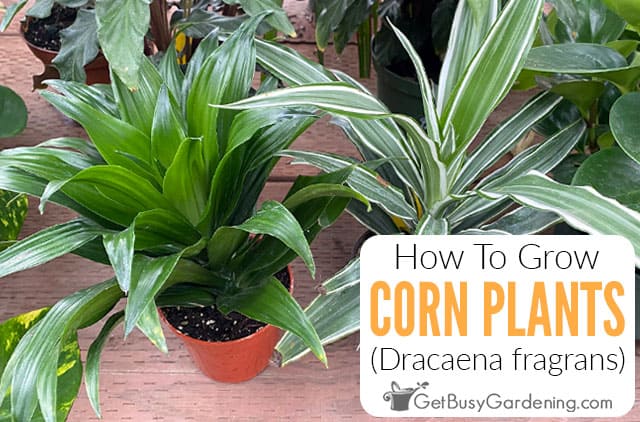
If you’ve ever stepped foot in the houseplants section of any garden center or big box store, then you will most likely recognize the corn plant.
They’re easy to spot because they look like… well, the vegetable plant that produces the corn we eat! That is what grabs most people’s attention, and causes them to do a double take.
There’s no doubt that Dracaena fragrans is one of the most popular indoor plants on the market, and has been for decades.
I mean, who can resist that gorgeous wide, glossy, dark green foliage. Plus, they look great in offices or homes, are very forgiving, and can easily adapt to various indoor light settings.
In this detailed guide, you’ll learn all about corn plant care, from how to provide the best water, light, and soil, to how to maintain a manageable size, and troubleshoot common problems to keep them thriving.
What Is An Indoor Corn Plant?
The corn plant, or Dracaena fragrans, is an evergreen tropical plant native to Africa. Its easy to care for, hardy nature has earned it the common name Happy Plant.
They feature thick, woody stems (aka canes) similar in appearance to palm trees. The canes vary in thickness, ranging from very skinny to 4” in diameter. Corn plants are slow growing, but over time can get as tall as 6’.
The sword-shaped leaves are glossy, green, and form a rosette shape along the top of the stems, giving them a pretty, layered arching look.
Different Types Of Corn Plants
There are several types of corn plants that you can grow. The most common is the ‘Janet Craig’ compacta with solid, deep green leaves.
Others include the white and green variegated ‘Warneckii’, and the ‘Massangeana’ variety, which have yellow stripes down the center.
You might also want to try ‘Lemon-Lime’, which features yellow or lime green margins around dark centers, or ‘Limelight’ with either solid pale green or yellowish leaves.
Though these varieties have different color patterns on the foliage, the care requirements are the same for all.
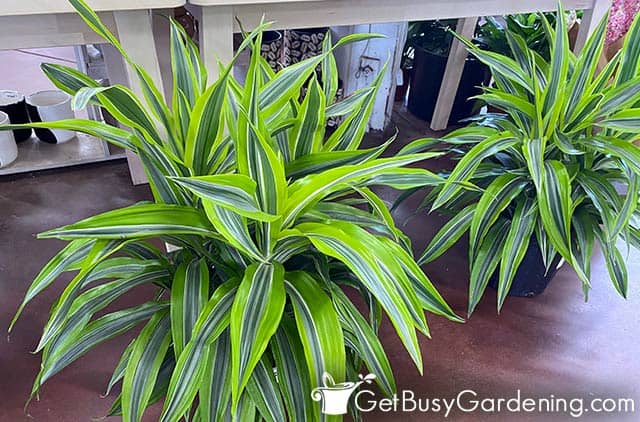
Dracaena Fragrans Flowers
Corn plants are most often grown for their foliage, but the ‘fragrans’ part of the name comes from the sweet aroma they put off during blooming.
Flowers form on a central stalk that begins to appear in late fall or early winter. The round pom pom shaped clusters contain several small white, tubelike buds. When they open, the star-shaped flowers release a sweet fragrance at night for up to 2-3 weeks.
Only mature plants flower, and even then it’s inconsistent. Some gardeners have theirs for decades before a flower stalk appears, and others see them bloom consistently year after year.
Dracaena Janet Craig Toxicity
Unfortunately for pet owners, corn plants are toxic to both cats and dogs according to the ASPCA website.
So if you have one, it’s best to keep them out of reach of pets and small children, just in case.
How To Grow Corn Plants
Before we chat about Dracaena fragrans care, first you need to know how to choose the best environment for growing them. A good location can help yours thrive for decades.
Related Post: Growing Plants Indoors – The Ultimate Guide
Hardiness
Though most corn plants are grown indoors in the US, they’re actually a perennial in zones 9-11.
They prefer temperature ranges between 55-75°F. When it drops below that they’ll start to suffer, and freezing weather will eventually kill them.
Where To Grow Dracaena Fragrans
Dracaena fragrans can be grown exclusively as houseplants, or they can spend the spring and summer outside and be overwintered indoors.
They do well in containers, especially terracotta ones that help wick away excess moisture. But they can get really tall and top-heavy over time, so choose a container accordingly to prevent them from tipping over.
Whether you keep them indoors or out, put them in a spot that is protected from the direct sun, or they can burn.
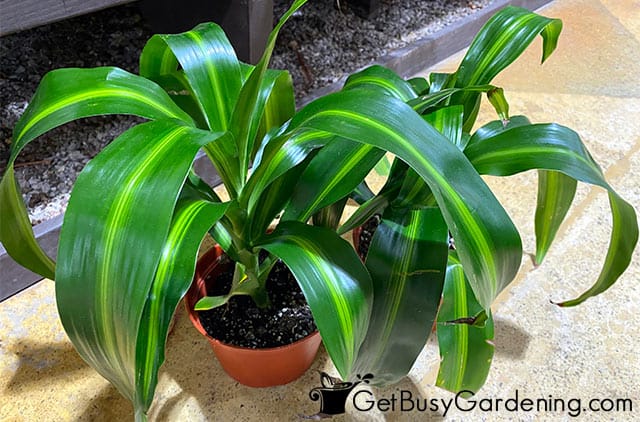
Corn Plant Care & Growing Instructions
With the perfect place in mind, it’s time to learn about how to care for corn plants. All the varieties can be tended to in the same way.
Sunlight
One of the reasons Dracaena fragrans are so well-loved is that they’re tolerant of a wide range of light conditions. They can live in low light indoor settings, or bright, indirect light.
The difference is in growth rate. They’re a slow plant anyway, but low light can all but halt it. In brighter settings, they’ll grow faster.
It’s also better for variegated varieties to have bright light, or even some direct exposure to filtered morning or evening sun, in order to maintain their color.
Outdoors, it’s best to keep them in a shaded or partial sun area protected from the intense afternoon rays. Direct sun exposure can cause sunburn or scorching on the leaves.
Water
Corn plants have average watering needs. They don’t like to dry out, but too much moisture can lead to stem rot, and mushy, brown, or blackening leaves.
Spring through summer, keep the soil evenly moist and water when the top inch is dry. Allow the excess to drain from the pot so they’re never left sitting in water.
In the fall and winter they need less moisture, so water when the soil is dry several inches down. Use a soil moisture gauge to get it just right.
These plants can also be sensitive to cold water or chemicals found in tap water. So you can either let it sit out for 24 hours, or use either distilled or rainwater instead.
Humidity
They tolerate average home humidity very well. But for dry environments, a pebble tray of water, occasional misting, or wiping the leaves with a damp rag can help.
Using a damp cloth is also a great way to keep them clean and dust free. If they start getting brown tips, then run a humidifier nearby to increase the moisture levels.
Fertilizer
Your Janet Craig compacta doesn’t require regular fertilizer. But like all plants, occasional feedings can help stimulate growth and keep them healthy.
They can be sensitive to chemicals, so I recommend using only natural or organic products, rather than synthetic ones.
Apply a diluted water soluble fertilizer, like compost tea or a general purpose one, once a month during the spring and summer. Or you can top-dress them with a granular one instead.
Stop feeding them in late summer, and don’t fertilize at all during the fall and winter months.
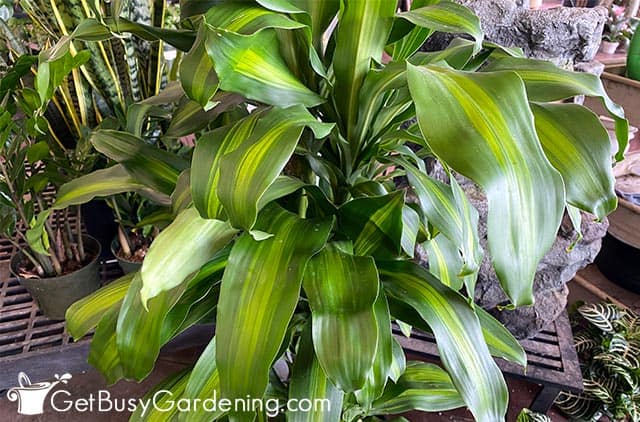
Soil
Corn plants aren’t picky, and a general purpose soil will work. But their best medium is a slightly acidic, rich, and fast draining one with a pH of 6-6.5.
You can use a palm tree potting mix, or one that is specifically made for tropical plants.
Otherwise, amend regular potting soil with coarse sand or pine bark to improve drainage. In the garden, mix in compost or worm casting to improve poor quality soil.
Repotting
Dracaena fragrans like to be slightly pot-bound, so only repot them when the roots have outgrown the current container.
If yours is still thriving in its container after three years, top-dress them with slow-release granules to rejuvenate the nutrients in the soil.
When the time comes for repotting, choose a container that is only one size larger, and make certain that it has drainage holes in the bottom.
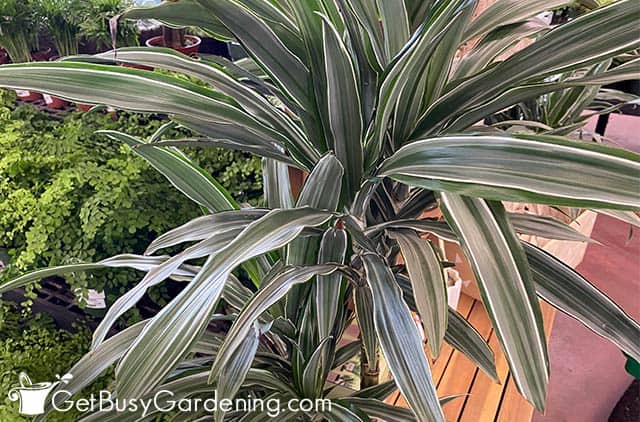
Pruning
There’s almost no need to prune the leaves as part of your corn plant care routine. They shed their bottom leaves as new ones grow, and this habit is a natural part of their life cycle. So trim those off as necessary
If yours has gotten too tall for its location, you can cut the cane down to a more manageable size in the spring by topping it.
The top can be rooted, and new leaves will begin to grow from the remaining stem over time.
Pest Control Tips
Pests are uncommon for all the varieties, but on occasion mealybugs, thrips, or scale insects can be an issue.
Neem oil, a natural insecticidal spray, or one made from 1 tsp gentle liquid soap with 1 liter of water, will help get rid of bugs.
Gently wiping or rinsing the leaves can help to immediately improve the problem too.
Corn Plant Propagation Tips
Dracaena fragrans is very easy to propagate through cane cuttings or air layering. This is especially useful for very tall trees, and keeps them to a more manageable size.
In the spring, simply cut the stem down to your desired height using a clean sharp knife or heavy duty pruners.
The crown, or the top part with leaves, can be immediately planted in moist soil. Dust it with rooting hormone, and place it on a heat mat, or in a warm location until it starts to put on new growth.
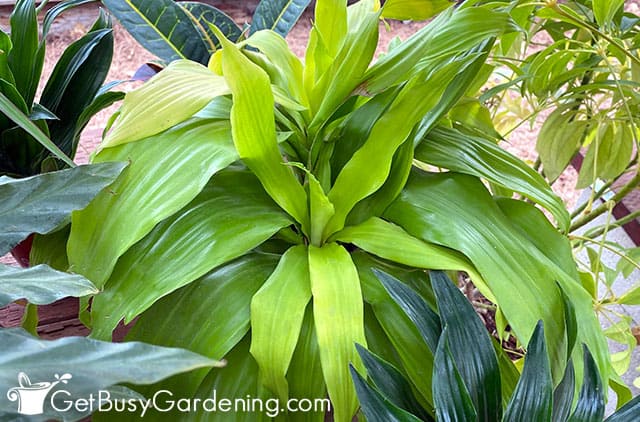
Troubleshooting Common Corn Plant Problems
Below are some tips for fixing the most common corn plant care issues you might experience. Though they are very tolerant of neglect, you may run into some of these problems over the years.
Brown Tips
I put this one first because Dracaena fragrans leaves are notorious for getting brown tips. This can be caused by lack of moisture, salt build up in the soil, or chemical fertilizer burn.
First check the soil moisture level. If it’s very dry, thoroughly water and keep a closer eye on it, making sure it never dries out completely.
If moisture is not the problem, and brown tips keep forming, it could be a buildup of salts or chemicals in the soil. You’ll know if you see a crusty, white or orange buildup on top of the soil, or around the inside of the pot.
You can flush the soil with distilled or rainwater by running it through the pot for 2 to 3 minutes. Then let the container drain off all of the excess.
In this case, I recommend you avoid using unfiltered tap water, and switch to a natural and organic fertilizer.
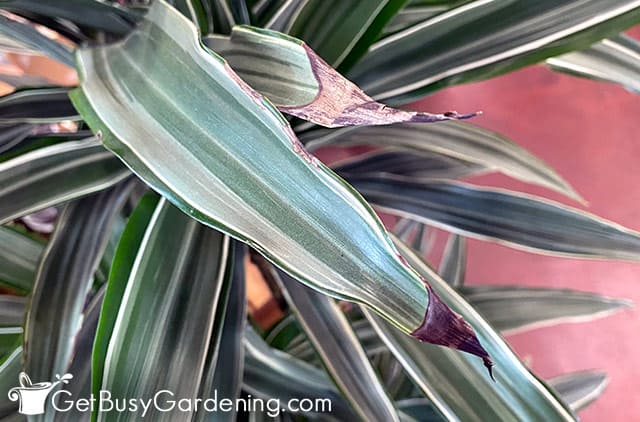
Leggy Stem
It’s common for the stem to look tall and bare over time. As corn plants grow, they shed their lower leaves, creating a crown at the top, and leaving the rest of the cane empty.
However, weak, thin, or curved canes can indicate a lack of light, especially if the leaves are also pale.
Either way, pruning the plant down can rejuvenate it. Be sure to move it to a brighter location or add a grow light to prevent it from happening again.
Leaves Turning Yellow
Yellowing lower leaves are normal, and part of their natural growth process. However, recent repotting or overwatering can also cause it.
As a corn plant grows, the bottom leaves will gradually turn yellow and fall off. This is nothing to worry about. It can also happen to a few lower leaves after a recent transplant.
If however several leaves are yellow and drooping, overwatering is probably the culprit. Let the top inch or two of soil dry between waterings.
Leaves Curling
Curling leaves can be a sign that your Janet Craig compacta is too cold or hot, or is receiving too much or too little water.
Keep it in temps between 55-75°F. Water when the top inch of soil is dry, but don’t let it get soggy, or keep the container sitting in water. If this is a struggle for you, a soil moisture gauge can help.
Curling leaves can also indicate a pest infestation, most commonly spider mites. So you should closely inspect the leaves for any signs of webbing or bugs.
Brown Spots On Leaves
Brown spots on the leaves rather than the tips are usually caused by sunburn, exposure to cold air, or trauma.
Move your indoor plant to a location away from direct sun, heat sources, or cold drafty windows. Keep your outdoor one in a more shaded location, and bring it indoors before it gets too cold.
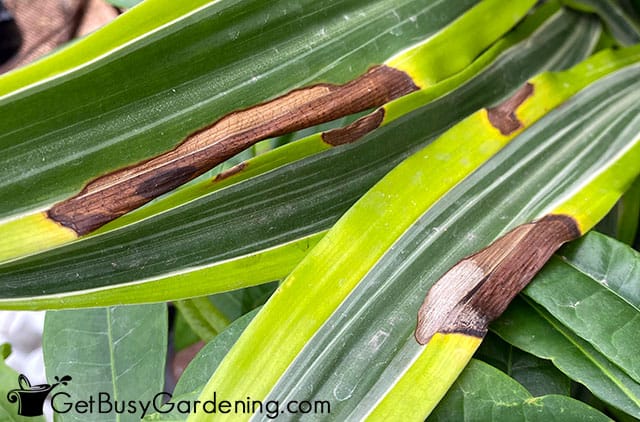
Corn Plant Care FAQs
Here you’ll find the answers to the most commonly asked questions gardeners have about corn plant care. If yours isn’t on this list, please ask in the comments section below.
How long do corn plants live?
Corn plants can live for many years, decades even, when you learn how to give them their best care.
How big does a Janet Craig compacta plant get?
A Janet Craig compacta plant can get up to 6’ tall, but it will take a long time for it to reach that size. Other varieties can be various heights.

Should I cut the brown tips off my corn plant?
You can cut the brown tips off of your corn plant if they bother you, but it isn’t necessary. Snip them at an angle to maintain the natural shape of the leaf.
Also make sure you look into the source of the brown tips to prevent them from recurring.
Is Janet Craig compacta poisonous?
According to the ASPCA website, Janet Craig compacta, and all other corn plant varieties, are poisonous to cats and dogs. So keep them out of reach of your pets and kids, just in case.
Do indoor corn plants grow corn?
No, indoor corn plants do not grow corn. They get their common name from the appearance of the foliage, which resembles the leaves of a corn stalk. But the two are not related.
With all the growing tips shared in this corn plant care guide, you have everything you need to keep any variety of Dracaena fragrans thriving for decades.
If you want to learn all there is to know about maintaining healthy indoor plants, then you need my Houseplant Care eBook. It will show you everything you need to know about how to keep every plant in your home thriving. Download your copy now!
More Houseplant Care Guides
- How To Care For Dracaena marginata (Madagascar Dragon Tree)
- How To Care For Umbrella Tree Plant (Schefflera arboricola)
- How To Grow ZZ Plant (Zamioculcas zamiifolia)
- How To Care For String Of Hearts (Ceropegia woodii)
- How To Care For Fiddle Leaf Fig Plant (Ficus lyrata)
- How To Care For Rubber Plants
- How To Care For Heart Leaf Philodendron (Philodendron hederaceum)
Share your corn plant care and growing tips in the comments section below.
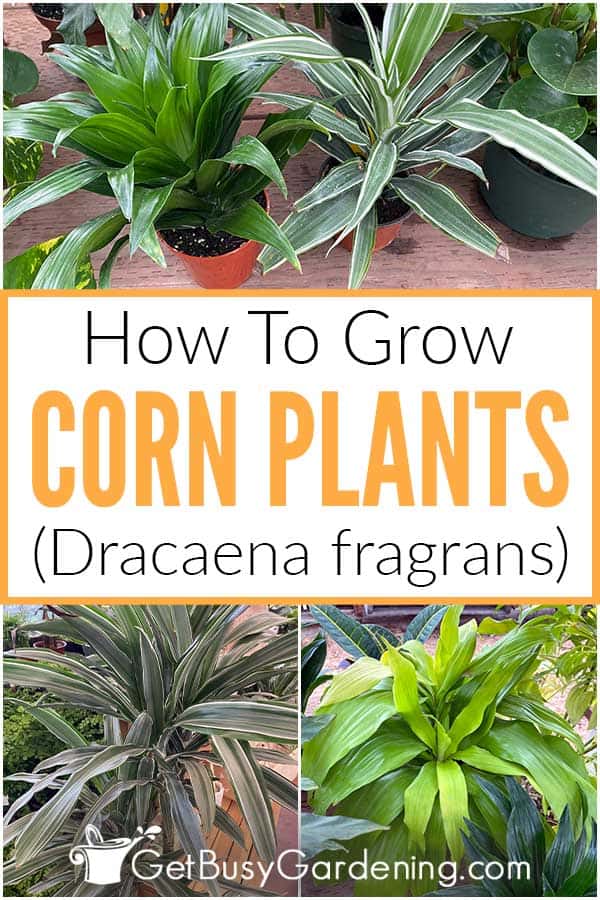
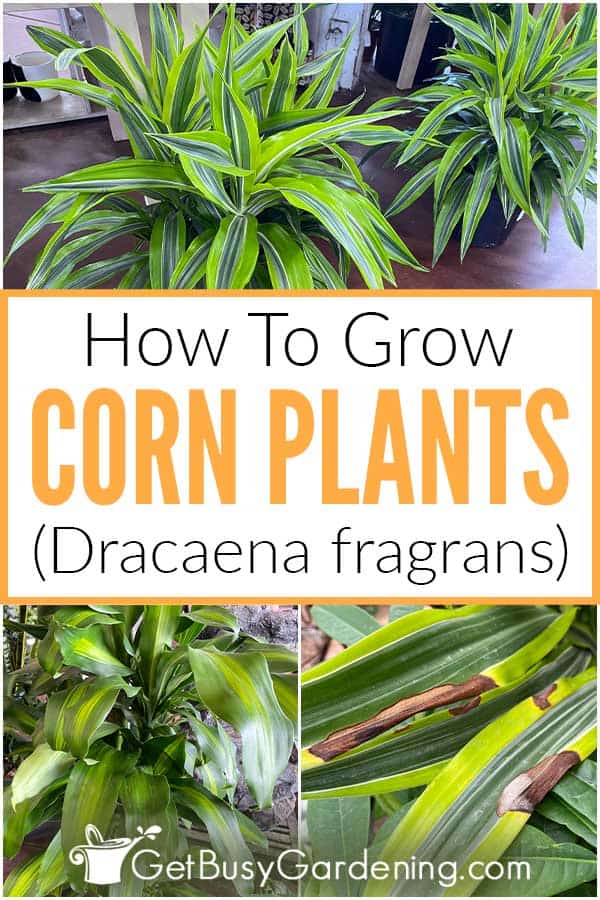
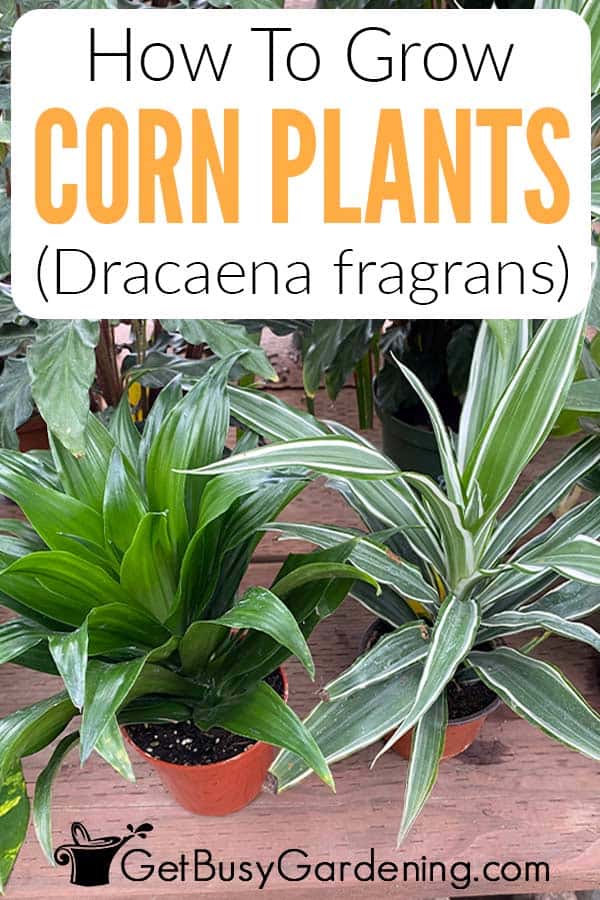



Joe Clymer says
Are self-watering pots good for corn plants?
Amy Andrychowicz says
I would not use a self-watering pot for your corn plant. They like the soil to dry between waterings, and using a self-watering pot can often lead to overwatering.